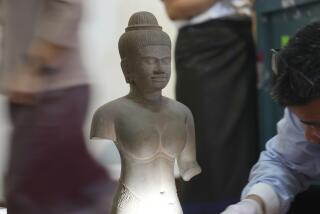Buddhist deities: clearing the way
- Share via
With four scowling faces, 12 eyes, 12 arms, numerous weapons, skulls adorning the rim of his crown, severed heads dangling from his waist, human figures crushed beneath his feet and his consort Vajravarahi wrapped about him in rapturous congress, Chakrasamvara is a force to be reckoned with.
He is one of many to be found in “Divine Demons: Wrathful Deities of Buddhist Art,” a small but captivating exhibition at the Norton Simon Museum.
When one thinks of Buddhist art, one tends to conjure images of tranquillity and bliss: Buddhas poised in beatific meditation and benevolent bodhisattvas hovering on lotus flowers.
“Divine Demons,” curated by Christine Knoke, presents a different picture. Its 18 objects -- bronze and brass figurines (like Chakrasamvara), paintings and ceremonial implements dating from the 13th through the 20th centuries and primarily from Tibet -- conjure a panoply of teeth-baring, arm-waving, serpent-stomping creatures who are there to step in when celestial composure is not enough.
They are not demons in the Christian sense but rather protectors of the Buddhist faith, defenders of the dharma. Their enemies are the obstacles to enlightenment: ignorance, delusion, pride, distraction, doubt, sloth, karma.
In some of the works -- as in an especially beautiful 19th century Tibetan painting centered on a blue-skinned fireball of a deity named Mahakala -- bodhisattvas and lamas float serenely above the action, as if protected from the taint of worldly struggle by Mahakala’s wall of flame.
The figurines have the air of personal talismans, symbolic objects intended to perform Mahakala’s role in the paint- ing on a human level -- in a temple, perhaps, or a home. (The exhibition doesn’t specify how the objects were actually used.)
Hayagriva -- with his three faces, six arms, eight legs and three horse heads sprouting from his forehead -- would serve as a fine bedside companion, posted to ward off evil dreams and insomniac anxieties. (He’s represented here in a gilt bronze statuette from 17th century Tibet or Mongolia.) A saucer-shaped metal mask from 20th century Tibet -- fang-like teeth, blazing eyebrows and gold-colored flames leaping round the face -- would make an auspicious door ornament.
If the paintings and figurines reflect the struggle pictorially, the ceremonial objects -- several daggers, an ax, a sword and a club -- enact it on the level of ritual, as demonstrated in several small photographs of the current Dalai Lama employing such objects in contemporary ceremonies.
In all, the works are ornate, absorbingly intricate and generally quite well preserved. The intimacy of the show allows for a degree of engagement and contemplation that can be harder to come by in the galleries that house the museum’s extensive permanent collection, from which this show is drawn.
As anyone who practices meditation knows, it is rarely the tranquil enterprise it appears. Indeed, the flames and skulls and vanquished figures on display here will strike a familiar chord with anyone who’s spent time coming to terms with the tempest of the self and attempting to cultivate control over the mind. The obstacles are many and the victories minute, and enlightenment -- whatever form of it one seeks -- can seem a dismally distant prospect.
Buddhist doctrine is known for its rigor, however, and the deities here set a fine example for graceful perseverance.
--
--
‘Divine Demons: Wrathful Deities of Buddhist Art’
Where: Norton Simon Museum, 411 W. Colorado Blvd., Pasadena
When: Noon to 6 p.m. Mondays, Wednesdays, Thursdays, Saturdays and Sundays; noon to 9 p.m. Fridays. Through March 8, 2010. Closed Tuesdays.
Price: $8
Contact: (626) 449-6840
More to Read
The biggest entertainment stories
Get our big stories about Hollywood, film, television, music, arts, culture and more right in your inbox as soon as they publish.
You may occasionally receive promotional content from the Los Angeles Times.










